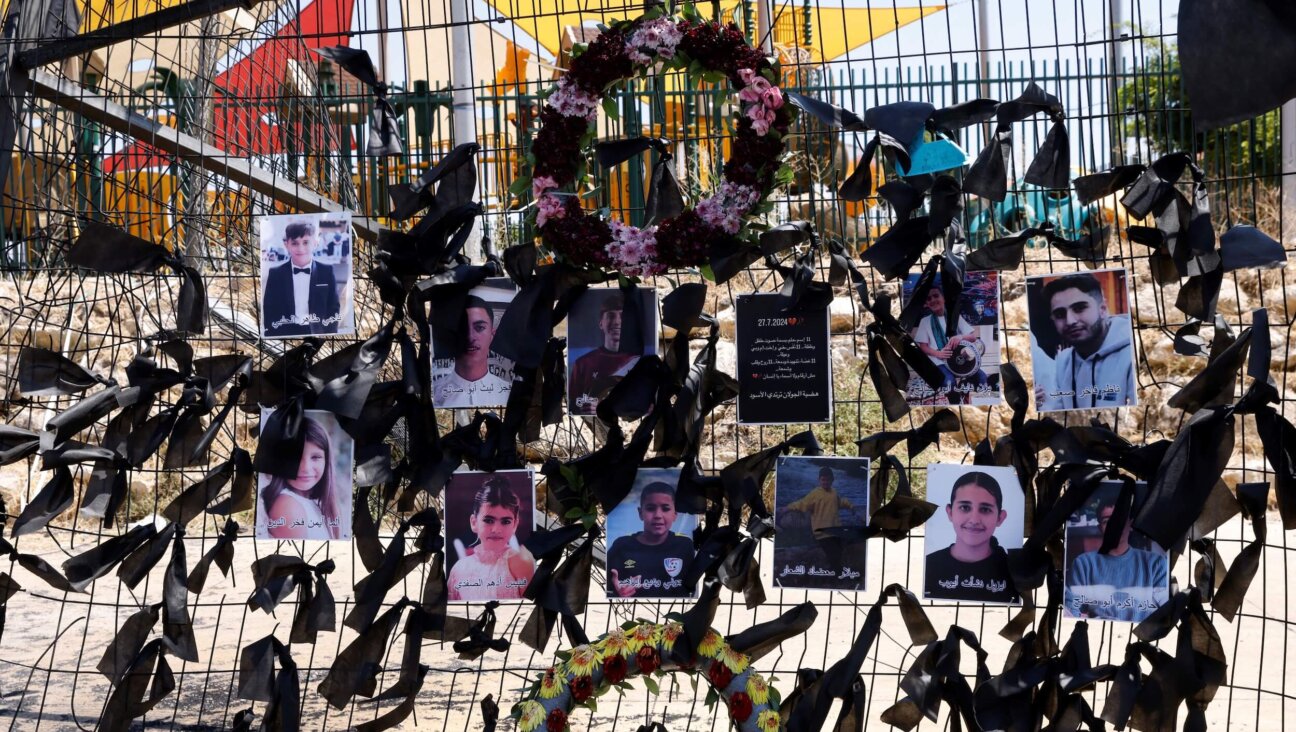Let Israelis and Palestinians Be Enemies

Image by YouTube
Despite what many people may believe, humanization between individuals does not resolve conflict between groups. And yet against all the hard evidence, most conflict management or simulation exercises still put this forward as their primary objective.
The Forward recently ran two articles about conflict negotiation simulations dealing with the Israel/Palestine dispute. Both mention the challenges and rewards of role-reversal, in which participants take on the part of their adversary during the course of the simulation.
But by citing the troika of dialogue and peace projects — humanizing enemies, encouraging an understanding of “the other” and developing mutual empathy — both models appear to be driven by the same unquestioned assumption that has ushered Palestine/Israel reconciliation movements into oblivion: that there is a relationship between mutual understanding among individuals and the end of violence or the achievement of peace between groups or nations.
There is no empirical evidence of this link, and especially not when applied to the Israel/Palestine conflict. On the contrary, 30 years of peace projects only appear to have produced small, self-selecting armies of “moderates” that have had little or no impact on the conflict, individuals who are often considered “sell outs” by their own people or are unable or unwilling to communicate with their own increasingly “hardline” publics. Despite all the courageous and diligent work involved in these projects, the conflict is sharper than ever, and more embittered by cumulative disappointments registered by peace efforts.
As one of the first to devise Israel/Palestine role reversal negotiations over a decade ago, inspired and trained by Barnard College historian Mark Carnes’s highly successful “Reacting to the Past” method, I have found that the emphasis on dialogue, empathy and humanization is misleading. In reality, the most powerful component of these modules is that they offer a unique space where adversaries can face each other without being pressured prematurely into friendship or asked to feel each other’s pain, and where their anger and hatred can be accepted, even respected.
Rather than drawing in the usual suspects or preaching to the converted, conflict simulations can be useful for those who otherwise would not walk within a mile’s reach of a dialogue group — even for members of the anti-normalization camp. Participants in such exercises need not engage in any personal dialogue with their enemies, or empathize with each other’s stories of victimization. Instead they engage indirectly, only while in role, a sort of psychological trick that allows them to contemplate and articulate concepts that are deeply threatening to them intellectually and emotionally, but for which they are not directly responsible (espousing, as they do, the opinions of someone else).
In the end, such simulations do compel participants to better understand their adversary, but not out of any sense of moral responsibility, virtuousness or respect for “the other.” Instead, they do so in order to take stock of their own options and the realities that their own people face. As a result, participants might rethink their approach to the conflict even when they do not change their mind about their enemies’ motives, rights or actions. They’re likely to query the effectiveness of their own strategies and goals, and closely analyze whether these are achievable. And they will often recognize the beliefs of their adversaries as facts on the ground that have to be addressed, no less powerful than any that can be seen or touched.
The results of this process are quite different from those that emerge from many peace and dialogue groups — not because the latter are not meaningful for individuals, but because whereas personal encounters may open hearts and minds, participants in these programs are rarely given tools to address their adversaries within the context of the conflict itself.
And the results are certainty different from the kind of work done by advocacy groups, where intra-community debate is subject to stringent rules of censorship, and where the goal is generally to learn only enough about your enemy’s stated positions so as to design a set of counter attacks and talking points. That’s a staggeringly superficial and ineffective strategy whose only success has been to deprive otherwise intelligent individuals of the insight they need in order to be effective advocates for their own cause.
In contrast to these approaches — both of which, for different reasons, avoid a confrontation with reality — a well designed simulation plunges participants into the heart of the conflict, where they analyze in great detail the social, economic, political, territorial, diplomatic and psychological obstacles to peace, from the perspectives of all parties that have a stake in its outcome.
These kinds of modules, which mirror the conditions of the conflict, can leave participants disheartened. They are specifically designed to avoid the happy endings and “out of the box” proposals generated by fictional or futuristic scenarios, which can be uplifting for participants but misleading for all involved. In contrast, individuals who participate in realistic modules often emerge humbled about their level of knowledge or understanding, pessimistic about the prospects for peace, disgusted by the internal politics and motives of various players, and shocked by the stark contrast between the goals they aspire to and the obstacles to achieving them in light of their adversaries’ mindsets and the realities on the ground.
Yet most participants are also exhilarated by the process itself, which provides them with a unique insider experience into the conflict’s dynamics and a wide range of parties’ perspectives. They emerge as confident, articulate people who recognize that they have a variety of choices for which they can assume responsibility, and are not beholden to prefabricated positions inherited from others. And they feel personally empowered by the sense that they possess a set of new skills and tools that they can deploy to discuss (and possibly address) the minutest details of each issue on a level that astonishes even professionals who partake in or observe the process.
Is there a conflict-relevant dialogue that emerges from this process? Yes, but it is not with the “other.” The most profound dialogue that results from a conflict simulation is within an individual, and between an individual and his or her own community. This kind of dialogue is more likely to help de-escalate the conflict in the long run, by leading parties to consider cleaning up their own house, rather than focusing exclusively on revealing the vices of their enemies.
Dr. Natasha Gill is author of “Inside the Box: Using Integrative Simulations to Teach Conflict, Negotiation and Mediation.” For many years she taught history, conflict studies and negotiation simulations at Barnard College and the New School University. In 2008 she founded her own organization, TRACK4, which runs conflict simulations for professionals.
















